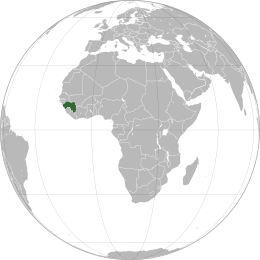Commons:Urheberrechtsregeln nach Gebiet/Guinea
|
Urheberrechtsregeln: Guinea Kürzel: COM:GUINEA | |
 | |
 | |
| Schutzfrist | |
|---|---|
| Standard | 80 Jahre p. m. a. |
| Fotografie | 40 Jahre p. m. a. |
| Anonym | Veröffentlichung + 80 Jahre |
| Audiovisuell | Veröffentlichung + 80 Jahre |
| Gemeinschaftswerk | Veröffentlichung + 80 Jahre |
| Posthum | Veröffentlichung + 80 Jahre |
| Angewandte Kunst | 40 Jahre p. m. a. |
| Andere | |
| Panoramafreiheit | Nein |
| Frist geht bis zum Jahresende | Ja |
| ISO 3166-1 alpha-3 | GIN |
| Abkommen | |
| Berner Übereinkunft | 20. November 1980 |
| Bangui-Abkommen | 18. Januar 1990 |
| Welthandelsorganisation-Mitglied | 25. Oktober 1995 |
| URAA-Wiederherstellungsdatum* | 1. Januar 1996 |
| WIPO-Urheberrechtsvertrag | 25. Mai 2002 |
| *Ein Werk ist in der Regel in den USA geschützt, wenn es sich um eine Art von Werk handelt, das in den USA urheberrechtsfähig ist, nach 31 December 1928 veröffentlicht wurde und im Ursprungsland am URAA-Datum geschützt ist. | |
Diese Seite bietet einen Überblick über die Urheberrechtsbestimmungen von Guinea, die für das Hochladen von Werken in Wikimedia Commons relevant sind. Beachte, dass jedes Werk, das aus Guinea stammt, sowohl in Guinea als auch in den Vereinigten Staaten gemeinfrei oder unter einer freien Lizenz verfügbar sein muss, bevor es auf Wikimedia Commons hochgeladen werden kann. Bei Zweifeln über den urheberrechtlichen Status eines Werkes aus Guinea solltest du die entsprechenden Gesetze zur Klärung heranziehen.
Hintergrund
France established control of Guinea in the late 19th century and administered the region as a territory within French West Africa. After a referendum, Guinea became independent on 2 October 1958.
Guinea has been a member of the Berne Convention since 20 November 1980, the World Trade Organization since 25 October 1995 and the WIPO Copyright Treaty since 25 May 2002.[1]
As of 2018 the World Intellectual Property Organization (WIPO), an agency of the United Nations, listed Act No. 043/APN/CP of August 9, 1980, adopting Provisions Relating to Copyright and Neighboring Rights as the main copyright law enacted by the legislature of Guinea.[1] WIPO holds the text of this law in their WIPO Lex database.[2]
Allgemeine Regeln
- Copyright shall subsist during the lifetime of the author and for 80 calendar years from the end of the year of his death. In the case of a work of joint authorship, the only date taken into consideration for the calculation of the term of protection shall be that of the death of the last surviving coauthor.[1980 Article 42]
- Copyright shall subsist for 80 calendar years from the end of the year in which the work is lawfully made accessible to the public in the case of anonymous or pseudonymous works, cinematographic works; posthumous works and collective works.[1980 Article 43 (a)]
- Copyright shall subsist for 40 calendar years from the end of the year of the author's death in the case of photographic works and works of applied art.[1980 Article 43 (b)]
Folklore: not free
Folklore belongs to the national heritage, where "folklore" means all literary and artistic creations made by authors presumed to be of Guinean nationality, passed from generation to generation and constituting one of the basic elements of the traditional Guinean cultural heritage. Public performance or direct or indirect fixation of folklore with a view to its exploitation for profit-making purposes shall require the prior authorization of the BGDA (Guinean Copyright Office) obtainable against payment of a fee.[1980 Article 5]
Domaine Public Payant
Siehe auch: Commons:Bezahlung des Gemeingutes
On expiry of the terms of protection referred to in Articles 42 and 43, during which a recognized exclusive right belongs to authors, their heirs or successors in title, the works of the author shall fall into the public domain. Exploitation of works in the public domain shall be subject to respect for moral rights, prior declaration and payment of a fee, the product of which shall be paid to the BGDA and used for cultural and social purposes for the benefit of authors. The right of exploitation or performance of works in the public domain shall be administered by the BGDA.[1980 Article 45]
Panoramafreiheit
Siehe auch: Commons:Panoramafreiheit
Nicht OK: Non-commercial use only under the 2019 law (but non-commercial content is not allowed here); free use in audio-visual media only under the repealed 1980 law.
Under the Law on the Protection of Literary and Artistic Property (Law L/2019/0028/AN):
- By way of derogation from authors' rights, it is permitted to reproduce, broadcast or communicate by cable to the public an image of a work of architecture, a work of fine arts, a photographic work or a work of applied arts permanently located in a place open to the public, unless the image of the work is the main subject of such reproduction or communication and if it is used for commercial purposes.[2019/0028 Article 27]
Under the now-repealed Act No. 043/APN/CP of August 9, 1980:
- It shall be lawful to reproduce in a film or in a television broadcast and to communicate to the public works of figurative art permanently located in a public place, or whose inclusion in the film or broadcast is only by way of background or is incidental to the essential matters represented.[1980 Article 14]
Siehe auch
Zitate
- ↑ a b Guinea Copyright and Related Rights (Neighboring Rights). WIPO: World Intellectual Property Organization (2018). Retrieved on 2018-11-05.
- ↑ Act No. 043/APN/CP of August 9, 1980, adopting Provisions Relating to Copyright and Neighboring Rights. Guinea (1980). Retrieved on 2018-11-05.